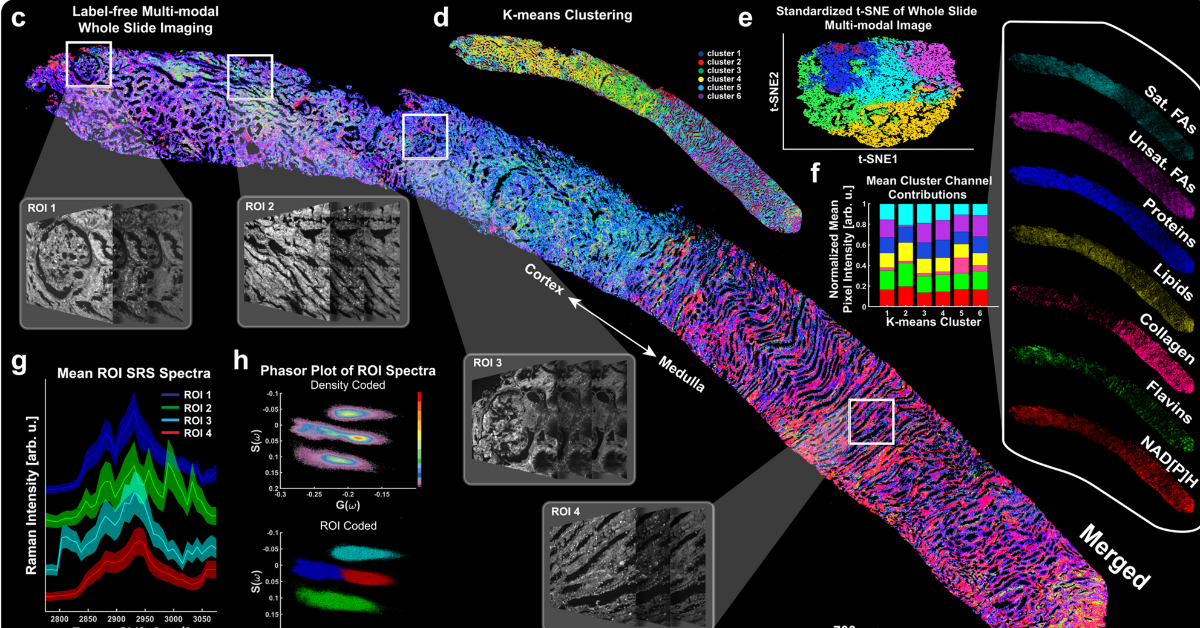A Clearer Look at Diabetic Kidney Disease via New Optical Imaging Technology
Engineers and clinicians working together developed an “optical biopsy” that could improve how kidney disease is diagnosed and studied. The new technology does not rely on stains or dyes.
Story by:
Published Date
Article Content
Scientists from the University of California San Diego and Washington University School of Medicine in St. Louis have developed a powerful new way to look inside kidney tissues—without needing to stain or damage the tissue samples. The new technique, called label-free multimodal optical biopsy, captures detailed, 3D images of kidney samples and reveals early signs of disease often missed by traditional methods.
Published in Nature Communications, the study introduces a new imaging system that uses lasers to detect critical changes in the kidney’s structure and chemistry. This includes identifying excess fat buildup, protein alterations, and tissue scarring—key warning signs of diabetic kidney disease, one of the leading causes of kidney failure worldwide.
“Think of it as a high-tech camera that can ‘see’ inside tissue without disrupting cells or requiring stains,” said Lingyan Shi PhD, co-corresponding author and professor in the Shu Chien-Gene Lay Department of Bioengineering at UC San Diego. “It gives us a more complete picture of what’s happening inside the kidney—and does it in 3D.”
Sanjay Jain MD PhD, co-corresponding author and professor of medicine, pathology and pediatrics at Washington University School of Medicine in St. Louis added, “This technology has enormous potential to improve how we diagnose and monitor kidney disease, especially in its early stages when intervention can be most effective. It provides us clues to what adjustments or adaptations are happening in the cells in diabetes and related metabolic disorders in the kidney.”
Anthony (Tony) A. Fung PhD is the study’s first author and a former bioengineering doctoral student and postdoctoral researcher in Shi’s bioengineering lab at the UC San Diego Jacobs School of Engineering and currently a postdoctoral researcher at Yale University. Fung led the development and integration of the imaging platform and data analysis pipeline used in this study while at UC San Diego.
Unlike traditional biopsy methods, which require multiple serial sections with chemical stains, co-registration post-processing, and risks physical slicing defects, this label-free approach preserves the sample while delivering rich, informative images that reflect underlying biology. When tissue availability is sparse, maintaining the flexibility for downstream processing is a key advantage of non-destructive label-free imaging.
To further enhance its impact, the team incorporated artificial intelligence to automatically detect signs of disease within the imaging data. This capability could one day help clinicians diagnose kidney problems more quickly and accurately, and personalize treatment plans for each patient.
The researchers hope this technology will not only improve early detection, monitoring, and treatment of kidney disease but also find applications in studying other diseases where metabolism and tissue structure are critical.
Article information
Anthony A. Fung , Zhi Li , Craig Boote , Petar Markov, Joseph P. Gaut, Sanjay Jain, Lingyan Shi, Label-Free Optical Biopsy Reveals Biomolecular and Morphological Features of Diabetic Kidney Tissue in 2D and 3D in the journal Nature Communications
DOI 10.1038/s41467-025-59163-w
Funding
The researchers are grateful for the support of the Washington University Kidney Translational Research Center (KTRC) for kidney samples. The researchers report grant funding from the NIH HuBMAP grant U54HL145608 (SJ, LS), Sloan research fellow award (LS), and UC San Diego startup funds (LS).
The researchers recognize Amanda Knoten and Kristy Conlon for patient enrollment and sample preparation.
Competing interests
A.A.F and L.S. are co-founders and shareholders of Raman Noodle Inc. The remaining authors have declared no competing interests.
Share This:
Stay in the Know
Keep up with all the latest from UC San Diego. Subscribe to the newsletter today.




